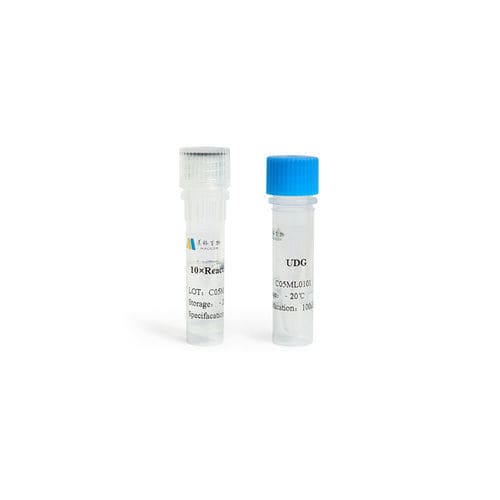
- Laboratory
- Laboratory medicine
- Enzyme reagent
- Guangzhou Magigen Biotechnology Co. Ltd
Enzyme reagent A018 seriesUDG enzymeRT-qPCRbacteria
Add to favorites
Compare this product
Characteristics
- Type
- enzyme, UDG enzyme
- Applications
- RT-qPCR
- Micro-organism
- bacteria
- Storage temperature
-20 °C
(-4 °F)
Description
Thermogenic UDG enzyme (uracil-DNA glycosylase) is screened and extracted and purified from lab-grown bacteria and, similar to UNG from E. coli, it hydrolyzes uracil-glycoside bonds in single or double stranded DNA, excises uracil, and produces alkali-sensitive, non-base sites in DNA. These baseless sites can be hydrolyzed by nucleic acid endonuclease, heating, or alkali treatment, and unlike UNG from E. coli, the enzyme exhibits low thermal stability and is therefore more likely to inactivate it. Depending on how the DNA is prepared, UDG enzymes can be used to achieve common site-specific or strand-specific U-DNA cleavage.
Unit Definition
One unit is defined as the amount of uracil-DNA glycosylase required to fully degrade 1 μg of purified single-stranded uracil-DNA (M13) within 60 minutes at 37°C.【Product Features】
U-DNA sites on single- and double-stranded DNA can be hydrolyzed, uracil glycoside bonds can be excised and alkali-sensitive base-free sites can be produced in DNA.
♦ It is active for both single- and double-stranded DNA.
♦ Inactive for RNA and DNA that is naturally free of uracil.
♦ There are no requirements for metal ions and are fully active in the presence of EDTA. However, residual activity in systems exceeding 100mM K+ or Na+ is approximately 70% of the original activity and increased use is required.
♦ The optimal reaction temperature is 37 ° C, but it has better activity in a wide range of 20-50 ° C, and 95 ° C can be completely inactivated at 2 minutes.
♦ The recommended amount of use in PCR is 0.2U-1U/25μl, and the recommended amount of use in one-step RT-qPCR and 55-65°C is not more than 0.2U/25 μl,
Exhibitions
Meet this supplier at the following exhibition(s):

Other Guangzhou Magigen Biotechnology Co. Ltd products
Reverse Transcriptase & PCR
Related Searches
- Solution reagent kit
- Molecular biology reagent kit
- Protein reagent kit
- Enzyme reagent kit
- Dye reagent
- PCR reagent kit
- Bacteria reagent kit
- Virus reagent kit
- DNA polymerase reagent kit
- Gene reagent kit
- Enzymatic reagent kit
- RT-PCR reagent kit
- RT-qPCR reagent kit
- Animal-based reagent kit
- DNA reagent kit
- Reverse transcriptase reagent kit
- CDNA synthesis reagent kit
- Phosphate reagent kit
- Amplification reaction reagent kit
- Nucleic acid reagent
*Prices are pre-tax. They exclude delivery charges and customs duties and do not include additional charges for installation or activation options. Prices are indicative only and may vary by country, with changes to the cost of raw materials and exchange rates.










